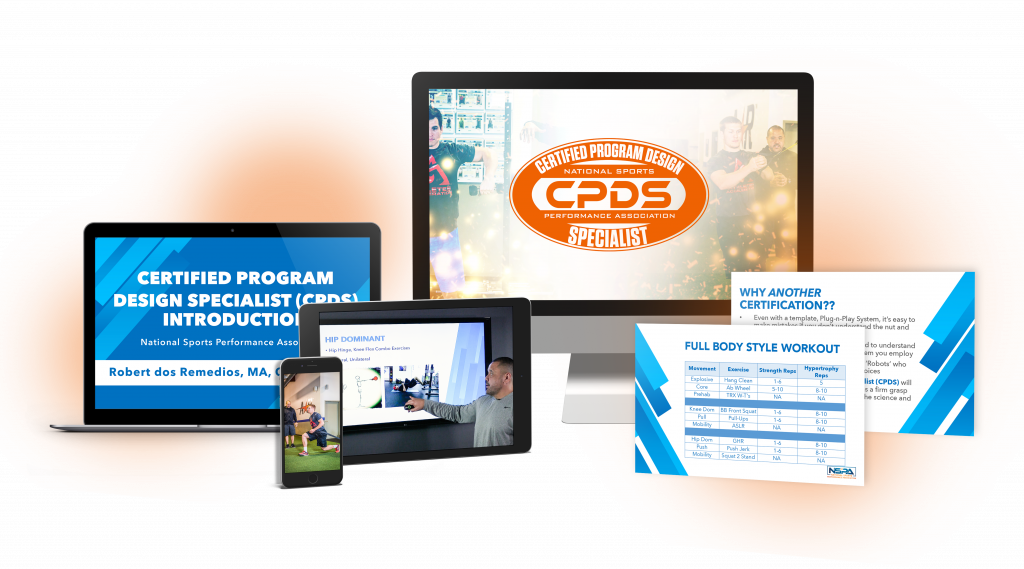Become a Certified Program Design Specialist
What often separates the okay trainers from the kinda-sorta good trainers to the great trainers is often their ability to write effective, thorough, albeit simple programs that help get people results.
As I’ve written about before, writing training programs can be a crap-shoot.
However, there aren’t many people better at that than Robert Dos Remedios. His Certified Program Design Specialist resource is currently on sale at $100 off the regular price and I think it’s a “must have” for any fitness professional looking to hone their program writing skills.1

Dos was kind enough to talk some shop with me on the topic of program design below. You should read it 1) because I said so and 2) because Dos knows his shit.
Dos Knows His Shit
TG: What your take on individualization? I mean, in the beginning, when someone has such little experience, how much individualization does someone need from a program design standpoint? How does it change from intermediate to advanced level lifters?
Dos: Individualization can often be over emphasized in training – it can also be unrealistic in many situations (think large teams without multiple coaches etc.). I personally don’t think we need to overthink this at times. The templates in CPDS allows for lots of individualization in terms of choosing exercises, types of program layouts, circuits etc. but the best part is that it keeps us honest and doesn’t let us overemphasize movements or leave out important exercises.

TG: Outside of a current injury, unique health history, or if someone happens to be training for something specific, most beginners don’t need that much individualization. It’s not uncommon for me to use a program I’ve already written for a new client and I just tweak it here when warranted.
Then, a month or two (or three) down the road, when he or she has a little more experience under the bar, that’s when I start to make it more individualized based off where technique breaks down, glaring weak points, etc. Just my two cents.
Okay, this will be a very vanilla question, but it HAS to be asked (and please feel free to drop as many f-bombs as you see fit). What are the most common mistakes you see trainers/coaches making when it comes to program design?
Dos: I think this is probably threefold: Overthinking things, trying to be different for the sake of being different, and simply making up internet style workouts that have never actually been tested on actual human beings.
Let me explain a bit….
With the first one, sometimes we think more complicated programs equate to better results. I think this is the complete opposite – I want to make things simple so we can focus on the important aspects of training, sound layouts, loading, and becoming great at performing movements.
For the second one I am referring to workouts like ones that sort of go against the majority of trainers or focus on one piece of equipment or movement. You know what I’m talking about….the guy who says “All you need to do is carries!” or the one that says “This (insert tool or piece of equipment of choice here) is all you need for a complete training session” – this is simply untrue, we know what movements NEED to be trained and we know the best exercises to train them.
For the third one I see lots of ‘outside the box’ thinking but like I always say it’s great to think outside the box…as long as you know what’s inside the box. There are some time-tested rules we need to follow before we get crazy with unrealistic protocols – just browse the internet for 5 minutes after googling “HIIT Circuits” and you will see what I mean, folks breaking rules without ever really knowing the rules.
TG: YES. I wish your answer in that last paragraph would be the litmus test for every trainer thinking about writing an ebook on program design who only has four months of experience in a commercial gym.
Are they are tenets of program design you feel are non-negotiable? And, if so, what are they?
Dos: OVERLOAD. I can’t stress this enough. I see too many trainers with programs that simply don’t work hard enough.
We cannot expect change without sacrifice….you should face some form of adversity (at least that little voice in our head that says ‘HEY! What the heck are you thinking?!” numerous times during your training regardless of your training goals.
The #1 premise of my training philosophy is WORK CAPACITY – building our conditioning, strength, and even our mental toughness so that we can continue to improve and thrive as we continue to train.
TG: I know you train a lot of athletes (and I “think” general pop too). Regardless, what similarities and differences are there when writing programs between the two?
Dos: In Men’s Health Power Training nearly 10 years ago I wrote about just this – that there are VERY FEW differences in how I write programs for my athletes and my general population clients.

Of course choice of exercises, intensities, even format of the workout may look different but we always go back to programming the essential movement patterns for each person.
For example, I would program an explosive exercise for both my college volleyball player and my 86 year old mother…..but they would look very different. I may use more of a Metabolic Resistance Training (MRT) circuit for a general population client vs. a full body “traditional” lifting session for my sport athlete…. But all the same essential movements will be programmed.
TG: What are some things about program design that some people give way more credence towards? You know, things that you look at and are like, “really?” What are some things you feel most people tend to gloss over?
Dos: I think the whole ‘whiteboard workout’ craze that we see really hosts a ton of problems – lots of programs that look to gas trainees for that crushed effect. Workout Dice, poster workouts with crazy, unrealistic HIIT protocols etc.
There’s a lot of ‘throw a bunch of stuff at people…get them tired…get them sore…and this will help people reach their goals.
An overall lack of actual PROGRAMMING is what I tend to see these days.
I think the thing people tens to gloss over is LOADING. Even the general pop client who is trying to get wedding dress ready needs to lift heavy stuff – I’m not saying we need to be max lifting but we need to be doing much more than burpees and tricep bicep curls…. This goes back to the overload comment I made earlier. Nothing great comes easy ;o)
TG: Lastly, What do you feel separates Certified Program Design Specialist from all the other similar resources out there?
Dos: I really don’t think there is anything like this available to folks – I like to feel like this is programming that has developed over years and years of training, literally thousands and thousands of ‘subjects’.


